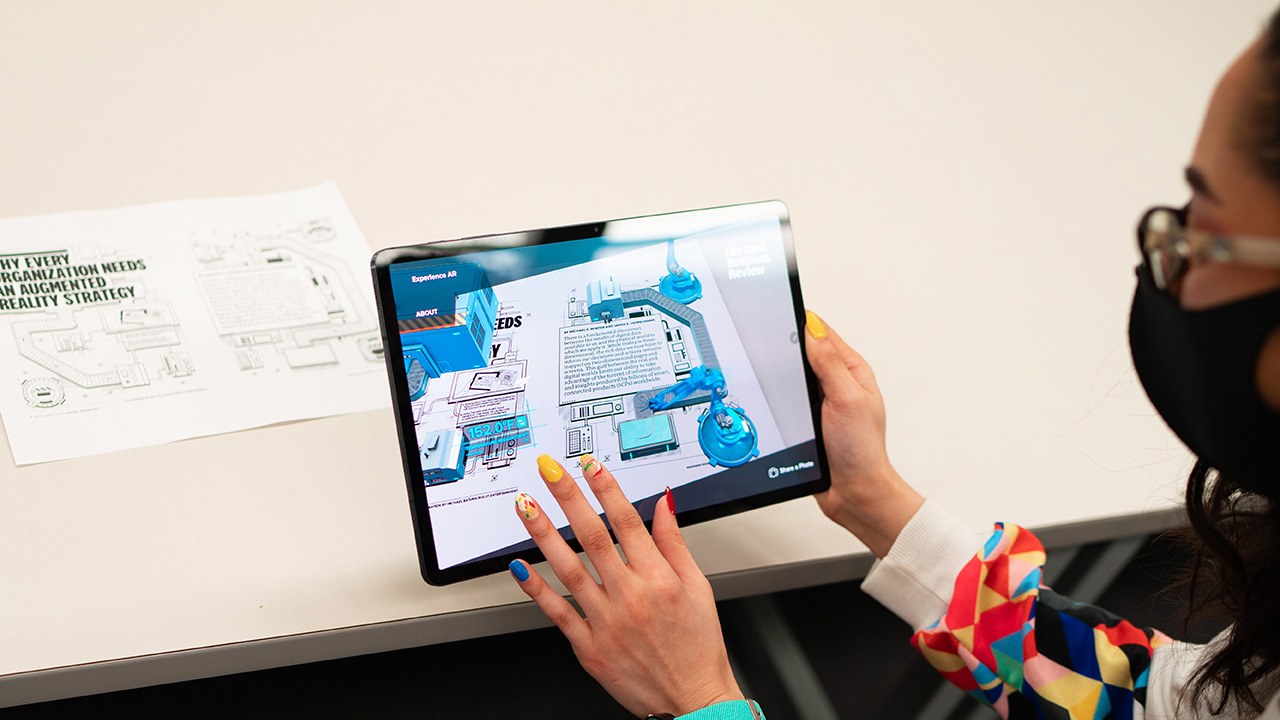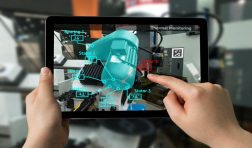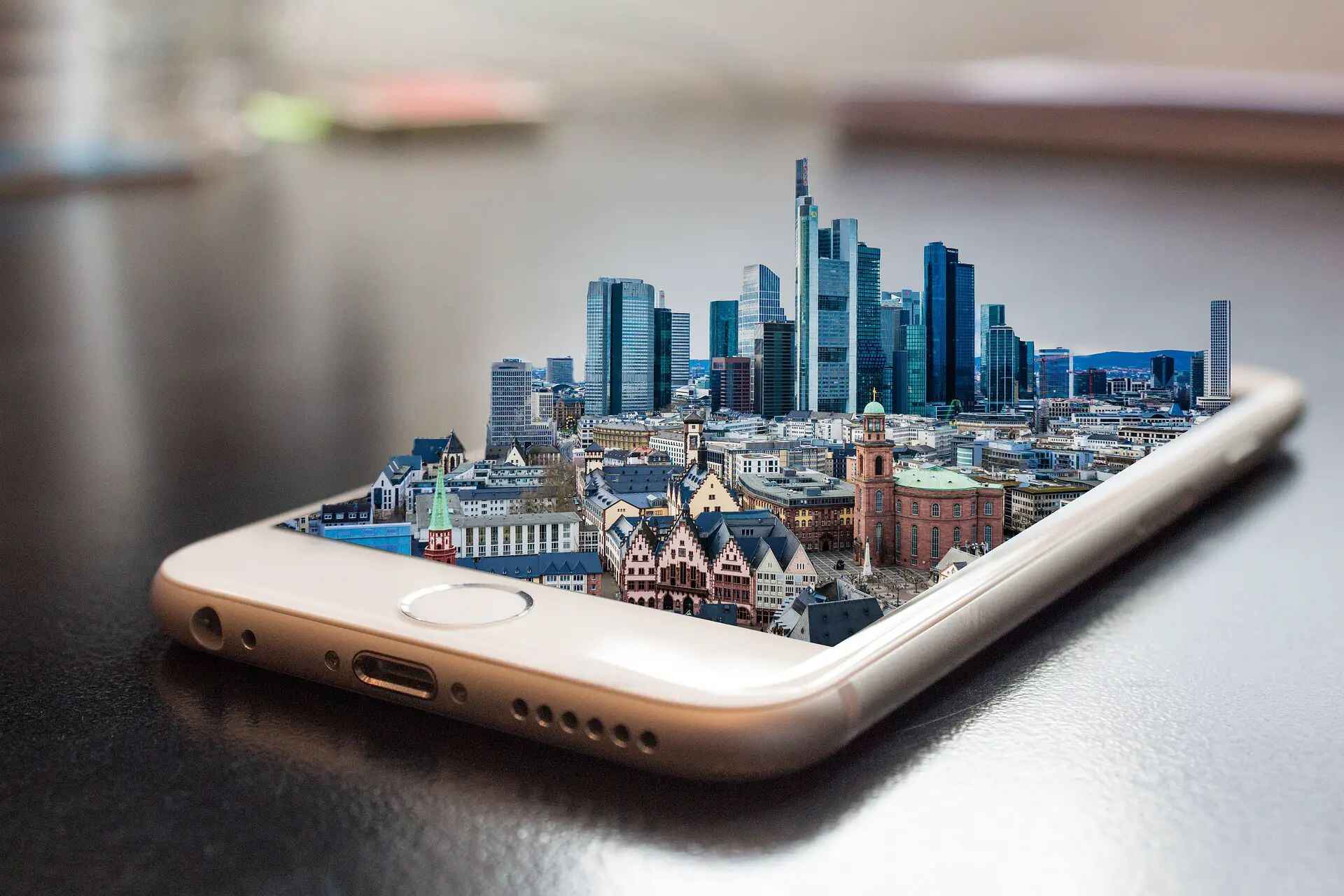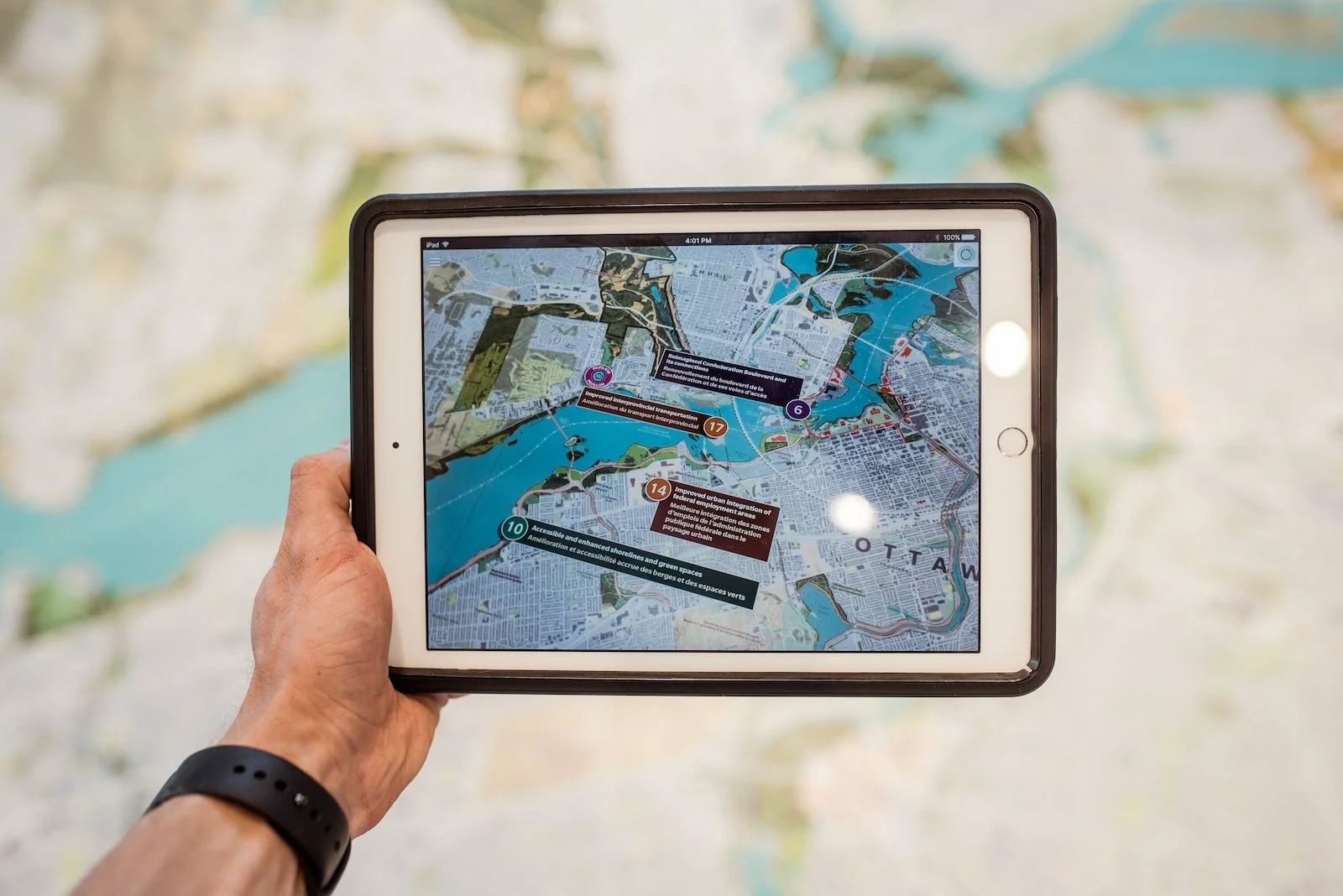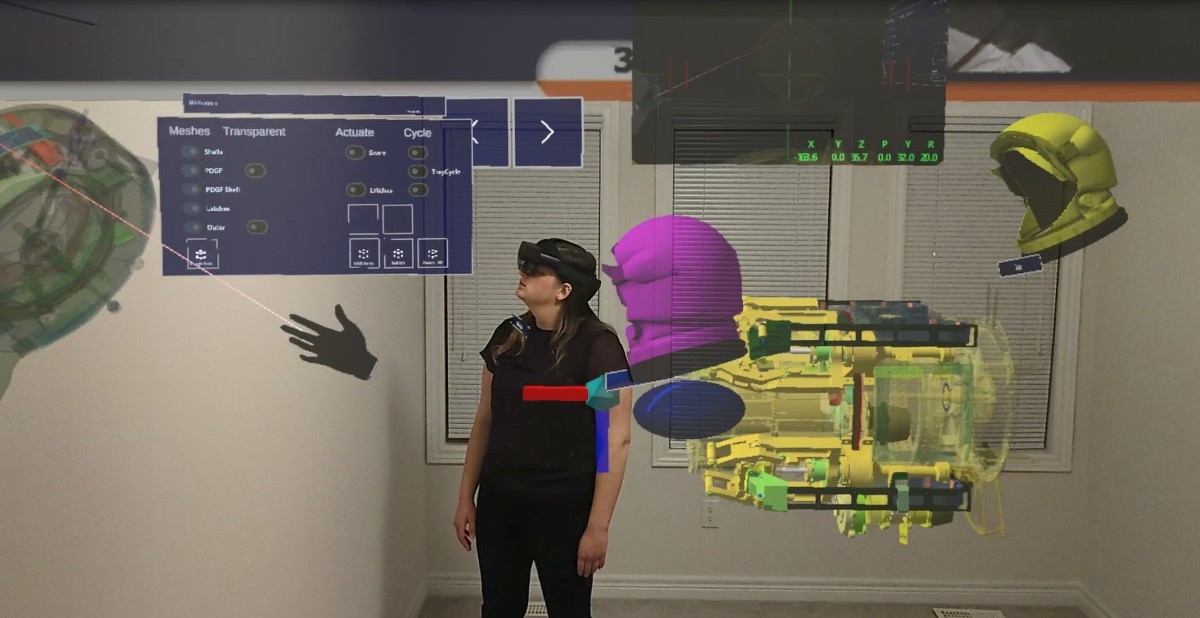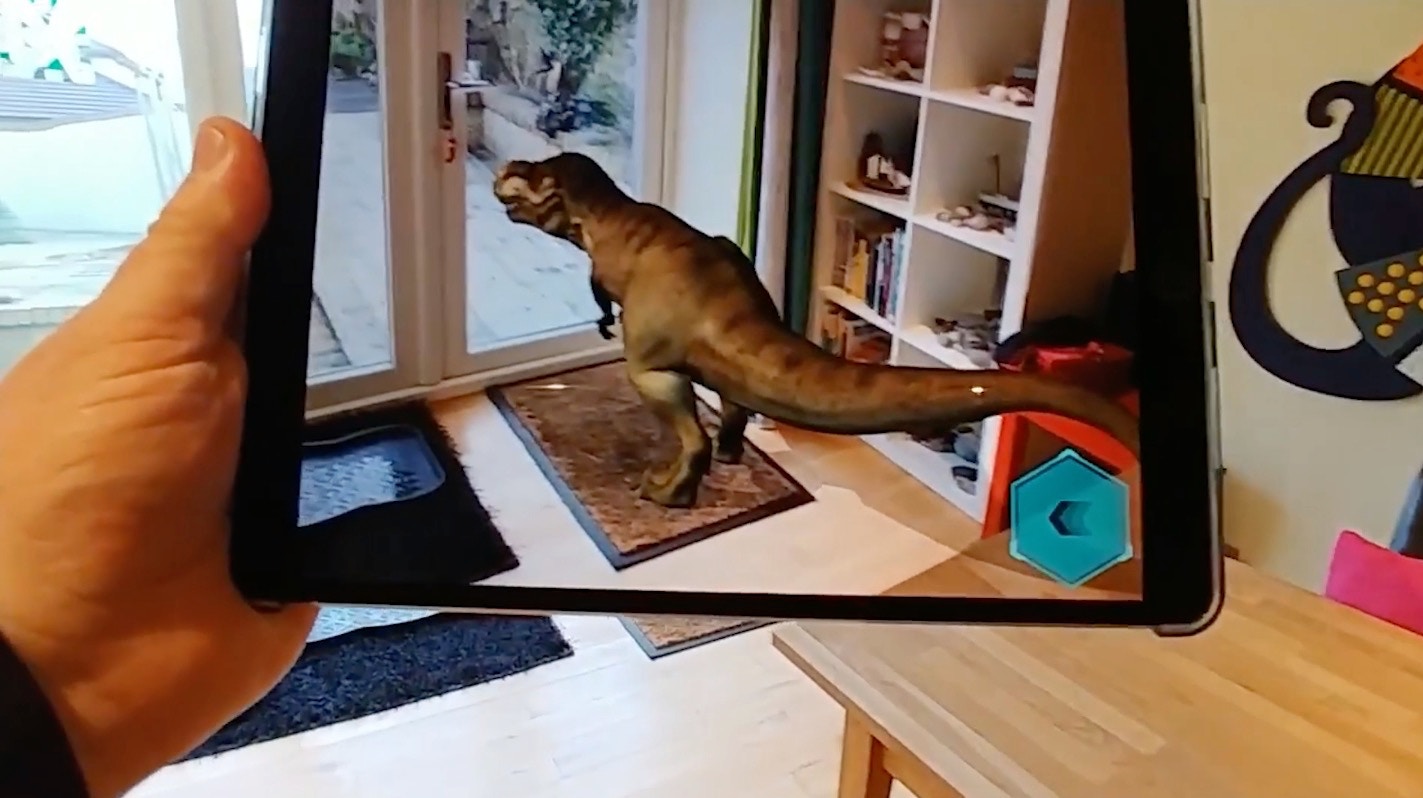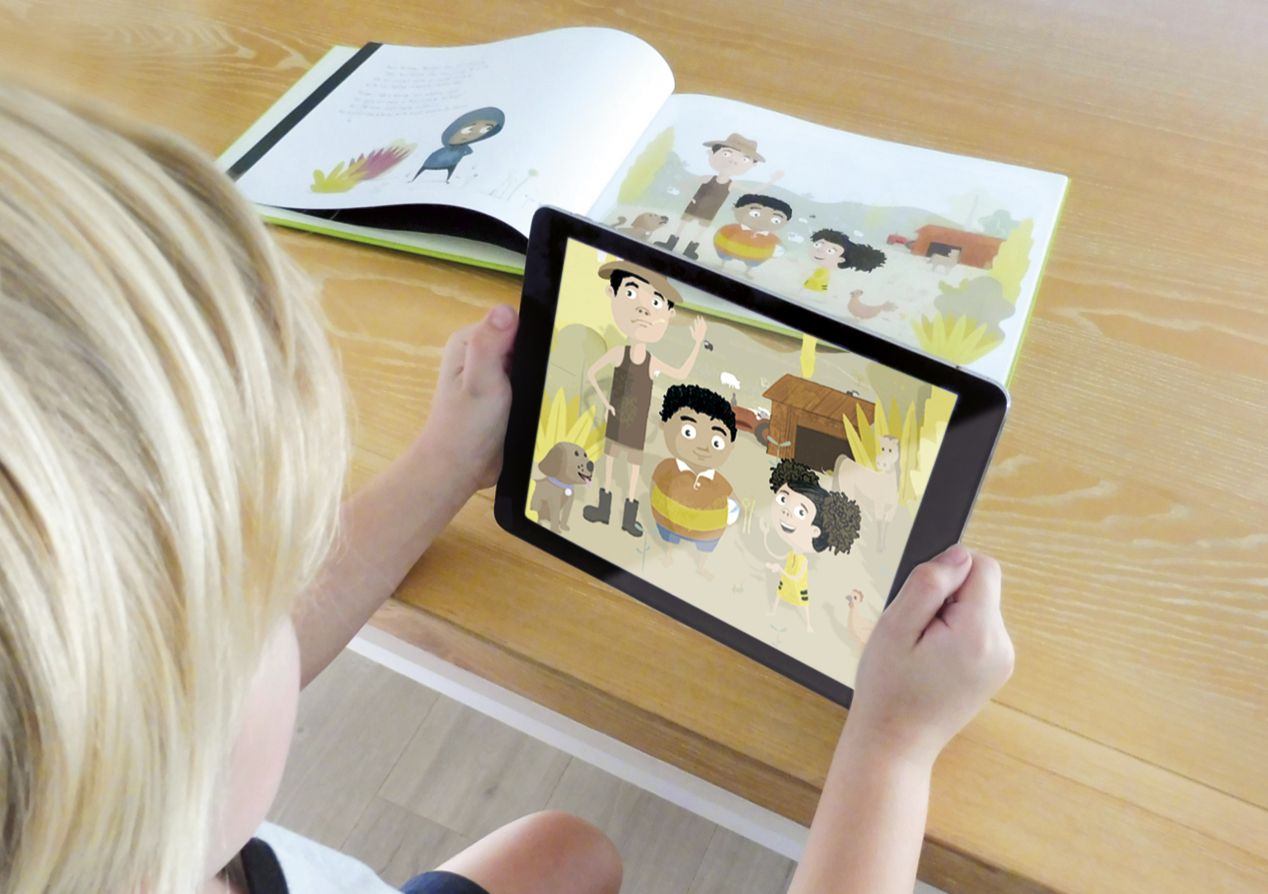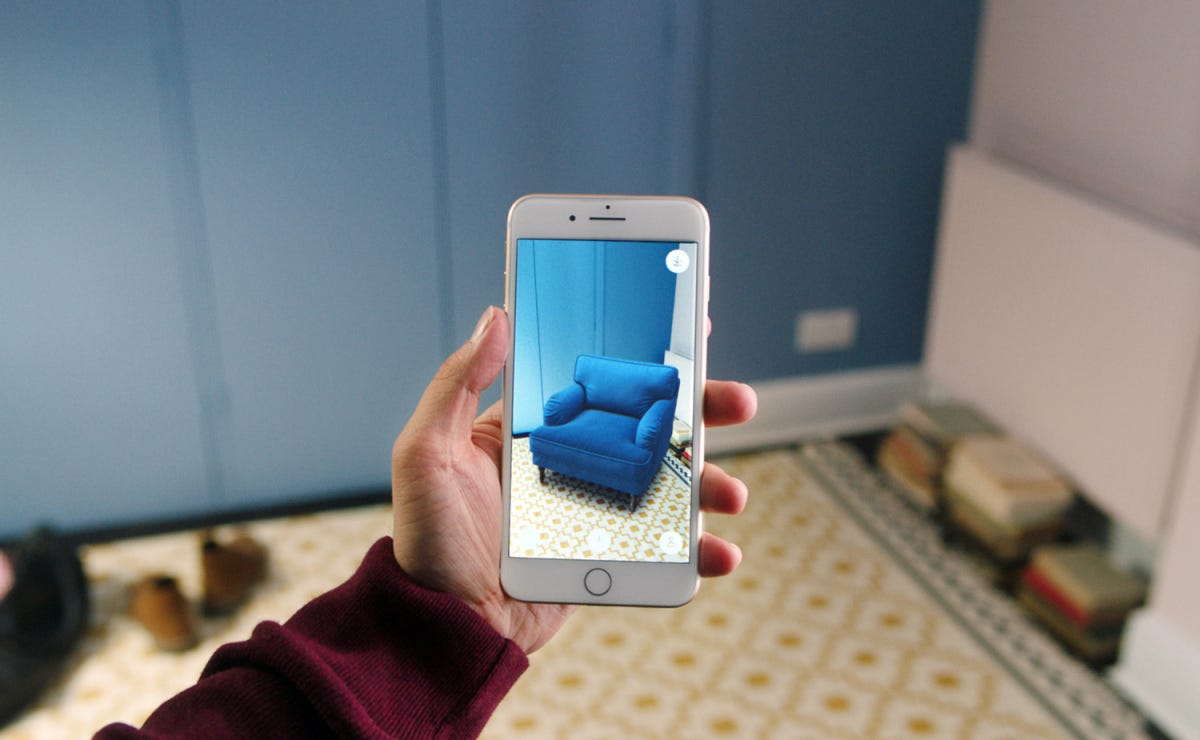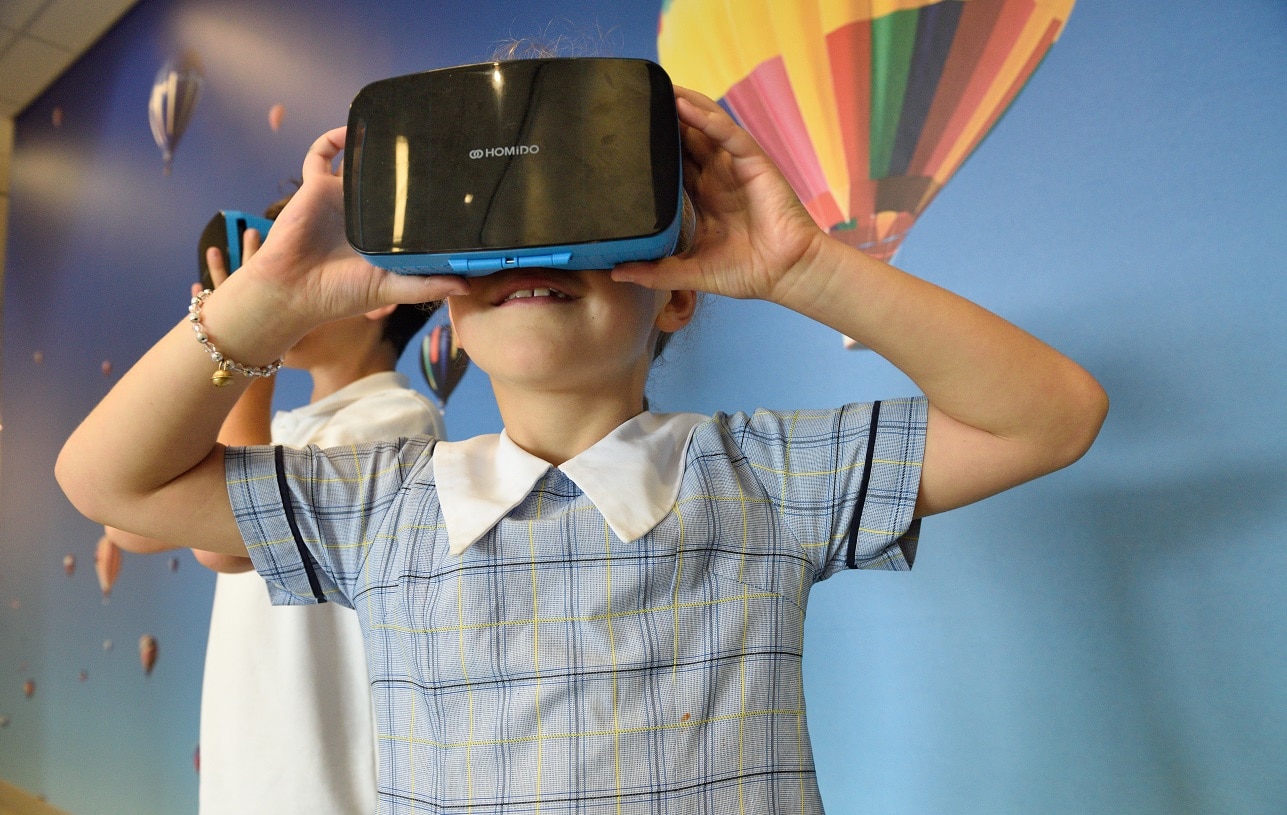Introduction
Welcome to the exciting world of augmented reality (AR). In recent years, AR has gained immense popularity and has revolutionized various industries. From gaming to education, marketing to healthcare, AR has opened up a whole new realm of possibilities and experiences.
AR technology seamlessly integrates virtual objects or information into the real world, enhancing our perception and interaction with the environment. Unlike virtual reality, which creates an entirely immersive and simulated experience, AR overlays digital content onto the real world, blending the two seamlessly.
So, whether you’re a tech enthusiast, a developer, or a curious individual looking to explore something new, getting into augmented reality will undoubtedly be an exciting journey. In this article, we’ll dive into the world of AR, exploring its basics, advantages, and the industries that are already leveraging its potential.
Moreover, we’ll provide you with practical insights on how to get started with AR, including choosing the right hardware and software, learning AR programming, and even creating your first augmented reality application. We’ll also discuss best practices for designing AR experiences, along with tips for testing and debugging applications.
Lastly, we’ll take a glimpse into the future of augmented reality and explore the emerging trends, giving you a broader perspective on the technology’s potential impact and opportunities.
Whether you’re an aspiring AR developer, a business owner looking to integrate AR into your marketing strategy, or simply a curious individual eager to stay up-to-date with the latest technological advancements, this article will serve as a comprehensive guide to help you navigate the exciting world of augmented reality.
What is Augmented Reality?
Augmented reality (AR) is a technology that combines virtual elements with the physical world, creating an interactive and immersive experience for users. It supplements our perception of reality by overlaying digital information, such as images, videos, or 3D models, onto real-world objects or environments.
AR enhances our interaction with the physical world by providing contextually relevant information in real time. It blurs the line between the digital and real world, offering a seamless integration of virtual and physical elements.
There are various methods of delivering augmented reality experiences. One common approach is through the use of AR-enabled devices, such as smartphones or tablets. These devices utilize the built-in camera, GPS, and sensors to detect the user’s position, orientation, and the surrounding environment. The AR content is then superimposed onto the device’s screen, creating the illusion that the virtual elements are part of the real-world scenery.
Another method of experiencing augmented reality is through head-mounted displays (HMDs), like AR glasses or smart glasses. These wearable devices offer a more immersive and hands-free AR experience, allowing users to interact with virtual objects in a more natural way.
The applications of augmented reality are vast and span across numerous industries. In gaming, AR has brought about a new era of interactive experiences, allowing players to engage with virtual characters and objects in their real-world surroundings. In education, AR has revolutionized learning by providing interactive and engaging content, bringing textbooks and historical artifacts to life. In the retail industry, AR has transformed the way customers shop by enabling virtual try-on experiences and showcasing products in 3D.
Furthermore, augmented reality is making significant strides in healthcare, architecture, engineering, travel and tourism, and many other sectors. From simulating surgeries and assisting doctors in diagnosis to visualizing architectural designs in real-world settings, AR is revolutionizing the way we perceive and interact with our environment.
As technology continues to advance, the potential for augmented reality will only grow. With advancements in computer vision, machine learning, and wearable technology, the possibilities of AR applications are limited only by our imagination.
In the next sections, we’ll delve deeper into the advantages of augmented reality, the industries that are utilizing this technology, and the steps you can take to get started with AR.
Advantages of Augmented Reality
Augmented reality (AR) offers numerous advantages that have led to its widespread adoption across various industries. By seamlessly integrating virtual elements into the real world, AR enhances our perception and interaction with the environment, bringing a host of benefits to businesses and users alike.
One of the key advantages of AR is its ability to provide immersive and interactive experiences. With AR, users can engage with digital content in their real-world surroundings, creating captivating and memorable interactions. From gaming and entertainment to educational experiences, AR brings a new level of engagement and excitement.
AR also has the potential to enhance productivity and efficiency in various industries. In fields like manufacturing, logistics, and maintenance, AR can provide real-time information and instructions overlaid onto physical objects, enabling workers to perform tasks with greater accuracy and speed. This results in improved workflow, reduced errors, and increased productivity.
Another advantage of AR is its potential to improve customer experiences. In retail, AR enables customers to visualize products in their own environment before making a purchase. They can try different furniture arrangements using AR apps, virtually try on clothing, or see how makeup products would look on their face. This not only enhances the customer’s confidence but also reduces return rates and fosters better buying decisions.
AR can also have significant benefits in the field of healthcare. Surgeons can use AR to overlay diagnostic images onto a patient’s body during surgical procedures, providing real-time guidance and improving surgical precision. Medical students can explore anatomy in 3D, enhancing their understanding and retention of complex concepts. AR can also assist patients in managing their health, delivering personalized instructions and reminders in a non-intrusive manner.
Furthermore, augmented reality has the potential to revolutionize training and skill development. AR simulations can provide realistic and interactive training experiences, allowing individuals to practice complex tasks in a safe and controlled environment. For example, airline pilots can undergo realistic flight simulations, and technicians can learn how to operate complex machinery, minimizing real-world risks and costs.
Lastly, AR has the advantage of being accessible and easy to adopt. With the proliferation of smartphones and AR-enabled devices, the barrier to entry for experiencing AR has significantly reduced. This accessibility opens up opportunities for businesses to leverage AR in their marketing strategies and engage with a wider audience.
As technology continues to advance, the advantages of augmented reality will only expand. The potential for AR in entertainment, education, healthcare, retail, and other industries is immense, offering improved experiences, increased efficiency, and countless opportunities for innovation.
In the next section, we’ll explore the various industries that are harnessing the power of augmented reality and how they are leveraging its benefits in their operations and customer interactions.
Industries Utilizing Augmented Reality
Augmented reality (AR) has found its application in a wide range of industries, transforming the way they operate and interact with customers. The seamless integration of virtual elements into the real world has opened up countless opportunities for innovation and enhanced user experiences.
One of the industries at the forefront of adopting AR technology is gaming. AR has revolutionized mobile gaming, allowing players to engage with virtual characters and objects in their real-world surroundings. Games like Pokémon Go brought AR to the mainstream, introducing a new level of interactive gameplay and social engagement.
The retail industry is also leveraging the power of augmented reality to enhance customer experiences. AR enables customers to virtually try on clothing and accessories, visualize furniture and home decor in their own space, and even see how makeup products would look on their face. By eliminating guesswork and providing realistic pre-purchase experiences, AR is revolutionizing the way people shop.
AR is also making significant strides in the field of education. It brings textbooks and learning materials to life, allowing students to interact with 3D models, explore historical events, and visualize complex concepts. AR applications in education foster immersive and engaging learning experiences, improving comprehension and retention.
In the healthcare industry, augmented reality is transforming medical training and enhancing patient care. Surgeons can utilize AR to overlay diagnostic images and real-time guidance during procedures, improving precision and minimizing risks. Medical students can practice complex procedures in a simulated environment, gaining practical skills in a safe and controlled setting. AR also has the potential to assist patients in managing their health and medication regimens through personalized instructions and reminders.
Architects, interior designers, and real estate professionals are also utilizing augmented reality to revolutionize their industries. AR enables clients to visualize architectural designs in real-world settings, allowing them to make informed decisions and envision the final product. In real estate, potential buyers can take virtual tours of properties and see how different furniture or renovation options would look in their prospective homes.
Moreover, manufacturers and maintenance technicians are leveraging AR to improve productivity and reduce errors. Through AR-enabled devices, workers can receive real-time instructions and visual cues overlaid onto physical objects, streamlining processes and ensuring accuracy. AR also enhances safety by providing interactive training experiences that simulate hazardous working conditions.
These are just a few examples of the industries that are utilizing augmented reality for various purposes. From entertainment and retail to education and healthcare, AR is transforming the way businesses operate and customers engage with products and services. As AR technology continues to evolve, more industries are likely to embrace its potential and explore new applications.
In the upcoming sections, we’ll guide you through the process of getting started with augmented reality, from understanding the basics to creating your own AR applications. So, let’s dive in and explore the exciting world of AR!
Getting Started with Augmented Reality
If you’re eager to dive into the world of augmented reality (AR), getting started may seem daunting at first. However, with the right resources and a step-by-step approach, you can embark on your AR journey with confidence. Here are some key steps to help you get started:
- Understand the Basics: Begin by gaining a solid understanding of the underlying concepts and principles of augmented reality. Learn about how AR differs from virtual reality, the technology involved, and the different types of AR experiences.
- Choose the Right Hardware and Software: Select the appropriate AR hardware and software tools based on your goals and budget. For beginners, utilizing smartphones or tablets with AR capabilities can be a cost-effective option. There are also dedicated AR devices, such as AR glasses and headsets, available for more immersive experiences.
- Learn AR Programming: Familiarize yourself with AR programming languages and frameworks. Unity and Unreal Engine are popular game development engines that offer AR capabilities. ARKit for iOS and ARCore for Android are platforms that provide AR development tools and libraries.
- Start with Simple Projects: Begin your journey by working on small, manageable AR projects. This could include creating simple AR markers, overlaying 3D objects on surfaces, or developing interactive AR games. Starting with simpler projects allows you to build your skills and confidence gradually.
- Explore AR Development Tools: Take advantage of AR development tools and platforms available in the market. These tools can streamline the development process and provide ready-to-use features, such as tracking, recognition, and rendering. Examples of such tools include Vuforia, ARToolkit, and Wikitude.
- Seek Learning Resources: Engage in online courses, tutorials, and communities to expand your knowledge and skills. Websites like Udemy, Coursera, and YouTube offer a wide range of AR development courses and tutorials. Joining online forums and communities can also provide valuable insights and support from fellow AR enthusiasts.
- Stay Updated with AR Trends: Follow the latest trends and advancements in the field of AR to stay informed and inspired. Keep an eye on industry events, conferences, and blogs that focus on augmented reality. This will help you stay ahead of the curve and discover new opportunities for AR application development.
Remember, getting started with augmented reality requires patience, practice, and a willingness to explore and experiment. As you gain more experience, you can challenge yourself with more complex projects and push the boundaries of what’s possible with AR.
In the next sections, we’ll delve deeper into the specifics of AR development, from choosing the right hardware and software to creating your first augmented reality application. So, let’s continue our journey into the exciting realm of augmented reality!
Understanding the Basics of Augmented Reality
Before diving into augmented reality (AR) development, it’s crucial to have a solid understanding of the basics. AR combines virtual elements with the real world, creating interactive and immersive experiences. Here are some key concepts to grasp:
- Overlaying Virtual Content: AR overlays virtual content, such as images, videos, or 3D models, onto the real world. This content can be superimposed onto physical objects or environments, enhancing our perception and interaction with the surroundings.
- Sensors and Tracking: AR relies on sensors in devices, like cameras and accelerometers, to gather real-world data. This data is used for tracking the user’s position, orientation, and the physical environment. It enables virtual objects to be precisely aligned and interact with the real world in real time.
- Marker-based vs. Markerless AR: Marker-based AR uses predefined markers, such as QR codes or fiducial markers, to trigger virtual content. When the marker is recognized by the device’s camera, the associated virtual content is displayed. Markerless AR, on the other hand, relies on computer vision techniques to recognize and track physical objects or features in the environment.
- Registration and Alignment: Registration involves aligning virtual content with the real world. It ensures that the virtual objects appear to be in the correct position and orientation relative to the physical environment. Alignment can be achieved through techniques like geolocation, GPS, image recognition, or depth sensing.
- Rendering and Display: Rendering is the process of generating and displaying virtual content onto the device’s screen. It involves techniques like 3D modeling, texturing, lighting, and visual effects. The rendered virtual content is then seamlessly blended with the camera feed, creating the illusion of virtual objects existing in the real world.
- Interaction and User Interface: AR applications provide various ways for users to interact with virtual content. This can include gestures, touch, voice commands, or even gaze tracking. Creating intuitive and user-friendly interfaces is crucial to ensure a seamless and natural user experience.
- Hardware and Software: AR experiences can be delivered through a range of devices, including smartphones, tablets, AR glasses, or headsets. Choosing the right hardware depends on factors like the desired level of immersion, portability, and processing power. Additionally, software tools and frameworks are used for AR development, providing libraries, APIs, and platforms for creating AR applications.
By understanding these fundamental concepts of augmented reality, you’ll be better equipped to dive into the world of AR development. You’ll be able to grasp the technical aspects and make informed decisions when choosing hardware, developing applications, and interacting with virtual content.
In the upcoming sections, we’ll guide you through the process of choosing the right hardware and software for AR development, as well as provide insights into the world of AR programming. So, let’s continue our journey into the exciting world of augmented reality!
Choosing the Right Hardware and Software
When it comes to developing augmented reality (AR) applications, choosing the right hardware and software is essential. The hardware you select will determine the level of immersion and the user experience, while the software tools will provide the necessary frameworks and libraries for AR development. Here are some key considerations to help you make the right choices:
Hardware:
Smartphones and Tablets: One of the most accessible options for AR development is utilizing smartphones or tablets. These devices are equipped with built-in cameras and sensors, making them capable of delivering AR experiences. ARCore (for Android) and ARKit (for iOS) are popular platforms that provide tools and libraries for AR development on smartphones and tablets.
AR Glasses and Headsets: For a more immersive and hands-free AR experience, consider using dedicated AR glasses or headsets. These devices provide a more natural and engaging way to interact with virtual content. Examples include Microsoft HoloLens, Magic Leap, and Oculus Rift. Each device has its own software development kit (SDK) and specific requirements for AR application development.
Compatibility and Technical Specifications: When choosing hardware, ensure that it is compatible with the AR development tools and platforms you plan to use. Consider factors like processing power, camera resolution, battery life, and comfort. High-resolution cameras, accurate sensors, and good tracking capabilities are essential for delivering an immersive and seamless AR experience.
Software:
Development Tools: Unity and Unreal Engine are popular game development engines that offer AR capabilities. They provide visual scripting and coding options, as well as easy integration of 3D models and assets. These engines have extensive communities and resources, making them ideal for beginners and experienced developers alike.
AR Platforms: ARCore (for Android) and ARKit (for iOS) are platforms specifically designed for AR development on smartphones and tablets. They provide APIs and libraries for motion tracking, environmental understanding, and light estimation. These platforms simplify the development process and enable you to create robust and advanced AR applications.
AR SDKs and Libraries: Various AR-specific software development kits (SDKs) and libraries are available to assist with AR development. Examples include Vuforia, ARToolkit, and Wikitude. These SDKs provide functionalities like image recognition, marker tracking, and object detection, simplifying the development process and allowing for faster prototyping and testing.
Documentation and Community Support: When choosing software tools, consider the availability of documentation, tutorials, and community support. These resources are invaluable for learning and troubleshooting during the development process. Explore online forums, developer communities, and official documentation to ensure you have the necessary support when needed.
Remember, the choices you make regarding hardware and software will depend on your specific goals, budget, and target audience. Consider the level of immersion, compatibility, technical requirements, and available resources to make informed decisions.
In the next sections, we’ll guide you through the process of learning AR programming and creating your first AR application. So, let’s continue our journey into the exciting world of augmented reality!
Learning Augmented Reality Programming
Learning augmented reality (AR) programming is an essential step in becoming proficient in developing AR applications. By familiarizing yourself with AR programming languages, frameworks, and tools, you’ll gain the necessary skills to create immersive and interactive AR experiences. Here are some key steps to get started:
Choose AR Programming Languages:
There are several programming languages commonly used in AR development. Depending on the platform and framework you choose, familiarize yourself with the following languages:
- C#: C# is widely used in AR development, particularly with Unity and the Vuforia SDK. It offers a user-friendly syntax and is well-documented, making it an excellent choice for beginners.
- JavaScript: JavaScript is commonly used in web-based AR applications. Libraries like AR.js allow for AR experiences directly in web browsers, making JavaScript a versatile option for web developers.
- C++: C++ is often used for AR development with frameworks like OpenCV, which provides computer vision capabilities. It is a powerful language that offers fine-grained control over hardware resources.
- Java: Java is widely used for Android AR development using the ARCore SDK. If you plan on developing AR applications for Android devices, learning Java is essential.
- Swift/Objective-C: These languages are used for AR development on iOS devices using the ARKit SDK. If you intend to develop AR applications for iOS, learning Swift or Objective-C is necessary.
Explore AR Development Frameworks and Tools:
AR development frameworks and tools provide libraries, APIs, and resources to streamline the development process. Here are some popular options to consider:
- Unity: Unity is a versatile game development engine that supports AR development for various platforms. It provides an intuitive interface, visual scripting options, and support for multiple programming languages.
- ARCore and ARKit: These platform-specific SDKs (Software Development Kits) provide the essential tools and libraries for developing AR applications on Android and iOS, respectively. They offer motion tracking, environmental understanding, and light estimation functionality.
- OpenCV: OpenCV is a computer vision library that enables AR developers to work with image recognition, object tracking, and more. It is written in C++ and has bindings for various programming languages.
- AR.js: AR.js is a JavaScript library that allows for web-based AR experiences. It supports marker-based AR and uses web technologies like WebGL to render and display AR content in web browsers.
Online Courses and Tutorials:
Taking online courses and following tutorials can greatly accelerate your learning process. Platforms like Udemy, Coursera, and YouTube offer a wide range of AR development courses, covering different aspects of AR programming and application development. These courses often provide hands-on exercises and practical examples to reinforce your understanding.
Join Developer Communities:
Joining AR developer communities, online forums, and social media groups can provide invaluable support and insights. Interacting with fellow developers allows you to share knowledge, learn from others’ experiences, and stay updated with the latest trends and advancements in AR programming.
By exploring AR programming languages, frameworks, and tools, and combining them with online courses and community engagement, you’ll build a strong foundation in AR development. Embrace hands-on learning, take on small projects, and continuously challenge yourself to expand your skills and create engaging AR experiences.
In the next section, we’ll guide you through the process of creating your first AR application, where you’ll put your AR programming skills to use. So, let’s continue our journey into the exciting world of augmented reality!
Creating Your First Augmented Reality Application
Now that you have a solid understanding of augmented reality (AR) programming, it’s time to put your skills into action and create your first AR application. By following these steps, you’ll be well on your way to developing an immersive and interactive AR experience:
Define Your Project:
Start by defining the scope and purpose of your AR application. Determine the target audience, desired user experience, and specific goals you want to achieve with your application. This clarity will guide your development process and help you stay focused.
Choose AR Development Tools:
Select the AR development tools and frameworks that align with your project requirements. Depending on your chosen platform (e.g., Unity, Android, iOS), utilize the appropriate AR SDKs and libraries, such as ARCore or ARKit, to access the necessary APIs and functions for AR development.
Create 3D Models or Assets:
If your AR application involves displaying 3D objects, create or obtain the necessary 3D models or assets. Use software like Blender, Maya, or Unity’s built-in tools to design and optimize your models for AR rendering.
Implement AR Tracking and Recognition:
Integrate tracking and recognition functionality into your AR application. This includes marker-based tracking or markerless tracking, depending on your project requirements. Ensure that virtual objects are consistently aligned and anchored in the real world using accurate tracking techniques.
Design the User Interface:
Create an intuitive and user-friendly interface for your AR application. This includes UI elements for interactions, such as gestures, buttons, or voice commands, to enable users to navigate and interact with the AR content seamlessly.
Implement Interactivity and Animations:
Add interactivity to your AR application by implementing user interactions, object manipulation, and animations. Enable users to interact with virtual objects, change their properties, or trigger animations based on specific actions or events.
Optimize Performance:
To ensure a smooth and responsive AR experience, optimize your application’s performance. Optimize rendering, minimize latency, and consider the limitations of the target device’s capabilities, such as processing power and memory. Test and iterate to achieve the desired level of performance.
Test and Debug:
Thoroughly test your AR application on the target devices, checking for any bugs, crashes, or inconsistencies. Verify that tracking is stable, virtual objects are properly aligned, and interactions function as intended. Collect feedback and iterate on your design based on user testing and observations.
Launch and Iterate:
Once your AR application is polished and tested, it’s time to launch it to your target audience. Deploy it on the appropriate app stores (such as Google Play Store or Apple App Store) or host it on web platforms for web-based AR experiences. Continuously gather feedback and make updates to improve user experience and add new features.
Creating your first AR application is an exciting and rewarding endeavor. It provides an opportunity to apply your learnings, stretch your creativity, and showcase your skills. Remember to keep learning, stay updated with emerging AR technologies, and continue exploring new possibilities to enhance your AR development expertise.
In the next sections, we’ll discuss best practices for designing AR experiences, as well as tips for testing and debugging AR applications. So, let’s continue our journey into the exciting world of augmented reality!
Best Practices for Designing Augmented Reality Experiences
Designing successful augmented reality (AR) experiences requires careful consideration of various factors to ensure an engaging and seamless user interaction. Here are some best practices to keep in mind when designing AR experiences:
Focus on User Experience:
Put the user at the center of your design by considering their needs, preferences, and limitations. Prioritize simplicity, intuitiveness, and clear instructions to provide a smooth and enjoyable AR experience. Minimize cognitive load and maximize usability to ensure users can easily navigate and interact with the AR content.
Design for the Physical Environment:
AR experiences are highly dependent on the real-world environment in which they are accessed. Design your AR application with the physical environment in mind, ensuring that the virtual content seamlessly blends with the real world. Optimize lighting conditions, account for varying surface textures, and consider environmental factors that may affect the overall experience.
Encourage User Exploration:
AR provides the opportunity for users to explore and discover virtual content in their surroundings. Design your AR experience to encourage user exploration by providing cues, hints, or subtle guidance. Guide users to interact with specific objects or areas, while still allowing for freedom and personal discovery within the AR scene.
Use Clear and Contextual Instructions:
Provide clear instructions and guidance within the AR experience itself to help users understand how to interact with the virtual content. Use visual cues, animations, or text instructions that are contextually relevant and appear at the appropriate time. Avoid overwhelming users with excessive information or instructions.
Ensure Realistic Object Placement and Scale:
Accurately align virtual objects with the physical world to create a seamless and believable AR experience. Pay attention to object placement, orientation, and scale relative to the surroundings. Ensuring that virtual objects interact realistically with the physical environment enhances the sense of immersion and credibility.
Optimize Performance for Smooth Interactions:
Prioritize performance optimization to ensure smooth interactions and responsiveness of the AR application. Minimize latency, optimize rendering, and consider the capabilities of the target device. This helps to enhance the overall user experience and prevent any disruptions or frustrations during interactions.
Consider Mobile Device Constraints:
When designing AR experiences for mobile devices, consider the limitations of screen size, processing power, and energy consumption. Optimize graphics and interactions to accommodate these constraints, ensuring that the AR experience remains accessible and enjoyable on a variety of devices.
Iterate and Gather User Feedback:
Continuous iteration and feedback are crucial for refining and improving your AR experience. Test the AR application with actual users and gather their feedback to identify areas for improvement. Iterate based on the feedback to enhance usability, address pain points, and deliver a more immersive and engaging AR experience.
By incorporating these best practices into your AR design process, you can create compelling and user-friendly AR experiences that captivate and delight users. Remember to adapt your design approach based on specific project requirements and target audience preferences.
In the next section, we’ll provide tips for testing and debugging AR applications, ensuring a smooth and error-free AR experience. So, let’s continue our journey into the exciting world of augmented reality!
Tips for Testing and Debugging Augmented Reality Applications
Testing and debugging are vital steps in the development process of augmented reality (AR) applications. Thorough testing ensures that the AR experience is smooth, reliable, and free from errors. Here are some tips to help you effectively test and debug your AR applications:
Test in Different Environments:
AR experiences can vary depending on the physical environment in which they are accessed. Test your application in various real-world settings, considering different lighting conditions, surface textures, and object placements. This helps identify any issues related to environmental factors that may affect the tracking or rendering of virtual objects.
Iterative Testing and User Feedback:
Conduct iterative testing throughout the development process, incorporating user feedback to refine your AR application. Involve testers who represent your target audience to gain valuable insights into usability, navigation, and overall user experience. Gathering feedback and making iterative improvements helps identify and address any potential issues early on.
Consider Different Devices and Operating Systems:
Test your AR application on a range of devices and operating systems to ensure compatibility and optimal performance. Consider factors such as screen size, processing power, and available sensors. This helps identify any device-specific issues and ensures a consistent and smooth AR experience across various platforms.
Monitor Performance and Latency:
Keep a close eye on the performance of your AR application, ensuring smooth and responsive interactions. Monitor frame rates, processing times, and latency to identify any areas that may require optimization. Addressing performance issues improves the overall user experience and prevents lags or hiccups during interactions.
Verify Real-World Object Alignment:
Check the alignment and positioning of virtual objects with respect to real-world surfaces or markers. Ensure that virtual objects are placed accurately in relation to the physical environment. Testing object alignment helps maintain the illusion of realism and enhances the overall credibility of the AR experience.
Test Interactions and User Interface:
Thoroughly test different user interactions and functionalities within your AR application. Verify that gestures, touch inputs, and other interactions work as intended. Test the user interface to ensure it remains intuitive, with clear navigational cues and instructions. Address any issues with interactions or UI elements to provide a seamless and user-friendly AR experience.
Implement Error Handling and Validation:
Incorporate error handling mechanisms and validation checks within your AR application. Anticipate potential errors related to tracking, rendering, or data processing and provide clear feedback to users when errors occur. Proper error handling improves the robustness and stability of the application.
Use Debugging Tools and Logs:
Utilize built-in debugging tools and logging mechanisms provided by your chosen development framework or SDK. This helps you track and trace issues during development and testing. Debugging tools can provide valuable insights into errors, exceptions, and performance bottlenecks, aiding in the identification and resolution of issues.
By following these testing and debugging tips, you can ensure that your AR application delivers a smooth, reliable, and immersive experience to your users. Thorough testing and bug fixing contribute to the overall success and quality of your AR application.
In the next section, we’ll explore advanced augmented reality technologies and techniques that can take your AR experiences to the next level. So, let’s continue our journey into the exciting world of augmented reality!
Exploring Advanced Augmented Reality Technologies
As augmented reality (AR) continues to advance, new technologies and techniques are emerging that can take AR experiences to the next level. These advancements open up exciting possibilities for developers and offer enhanced user experiences. Let’s explore some of the advanced AR technologies you can consider:
SLAM (Simultaneous Localization and Mapping):
SLAM is a technology that enables devices to understand and navigate the physical world in real time. It combines sensor data, such as camera input and motion tracking, with advanced algorithms to create a 3D map of the environment. SLAM allows virtual objects to be accurately placed and interacted with in real-world settings, enhancing the realism and immersion of AR experiences.
Depth Sensing:
Depth sensing technologies, like Time-of-Flight (ToF) cameras or structured light sensors, enable devices to capture depth information about the scene. This additional depth data enhances the accuracy of object detection, tracking, and occlusion in AR applications. By understanding the depth of the environment, AR experiences can seamlessly interact with physical objects and surfaces, resulting in more realistic and immersive interactions.
Object Recognition and Tracking:
Advanced techniques in computer vision and machine learning have improved object recognition and tracking capabilities in AR. Deep learning models and algorithms can recognize specific objects or features in the environment, allowing virtual content to intelligently interact with them. For example, virtual characters can recognize and respond to specific physical objects or gestures, blurring the line between the real and virtual world.
Spatial Audio:
Spatial audio enhances the auditory experience in AR applications by providing sound that appears to come from specific locations in the virtual or physical environment. By integrating spatial audio, users can perceive 3D sound cues as they move or interact with virtual objects, creating a more immersive and realistic audio experience.
Real-Time Collaboration:
Real-time collaboration enables multiple users to simultaneously interact with the same AR environment, fostering shared experiences and collaboration. This technology allows users in different locations to interact with and manipulate virtual objects together in real time, enabling novel applications in fields like remote assistance, virtual meetings, and education.
Gesture and Gaze Tracking:
Gestures and gaze tracking technologies enable users to interact with AR content using intuitive gestures and eye movements. This technology detects and interprets hand movements or eye positions, allowing users to manipulate and control virtual objects with natural gestures. Implementing gesture and gaze tracking enhances user engagement and provides a more immersive and hands-free AR experience.
AR Cloud:
AR Cloud technology aims to create a shared and consistent AR experience across different devices and locations. It allows for the persistence of virtual objects in the physical world, enabling users to view and interact with the same AR content in various contexts. AR Cloud provides a foundation for multi-user, multi-platform AR experiences and presents opportunities for social interactions and information sharing.
By exploring and incorporating these advanced AR technologies into your applications, you can create even more compelling and immersive AR experiences for your users. Keep an eye on the latest advancements, experiment with different techniques, and push the boundaries of what’s possible in augmented reality.
In the next section, we’ll look ahead at future trends in augmented reality, giving you a glimpse of what’s on the horizon. So, let’s continue our journey into the exciting world of augmented reality!
Future Trends in Augmented Reality
The future of augmented reality (AR) holds immense potential, with exciting developments and advancements expected to shape the AR landscape. Here are some key trends that are expected to drive the evolution of AR technology:
Wearable AR Devices:
As AR technology continues to mature, we can anticipate the rise of more sophisticated and user-friendly wearable AR devices. These devices, such as smart glasses and contact lenses, will offer a seamless and immersive AR experience without the need for handheld devices. Wearable AR devices will provide hands-free interactions, enhanced visual displays, and improved convenience, ultimately becoming an integral part of our daily lives.
5G Connectivity:
The advent of 5G networks will significantly impact the capabilities of AR applications. With ultra-fast data transfer speeds and minimal latency, 5G technology will enable real-time streaming of high-resolution AR content, making it possible to deliver more immersive and interactive AR experiences. 5G connectivity will also support multi-user AR applications and facilitate seamless collaboration and communication in augmented reality environments.
AR Cloud and Persistent AR:
AR Cloud, an emerging technology, aims to create a persistent and shared AR experience across devices and locations. This technology will enable virtual objects to have a long-term presence in the physical world, allowing users to view and interact with them over time. AR Cloud will drive the growth of multi-user, multiplayer AR experiences, revolutionizing social interactions and opening up new possibilities for remote collaboration, gaming, and education.
Integration with Internet of Things (IoT):
Integration of AR and IoT technologies will lead to a convergence of the physical and virtual worlds. With AR acting as the visual interface, IoT devices will seamlessly interact with the user, providing real-time information and control over connected objects. AR will enhance the way we interact with smart homes, smart cities, and various IoT-enabled devices, offering a more intuitive and immersive experience.
Advanced Computer Vision and AI:
Advancements in computer vision and artificial intelligence (AI) will continue to enhance AR experiences. These technologies will enable more accurate object recognition, occlusion handling, and real-time analysis of the environment, leading to improved tracking and realistic virtual object interactions. AI algorithms will make AR applications more intelligent, allowing for better context understanding, personalized recommendations, and adaptive user experiences.
AR for Training and Simulations:
AR will play a significant role in training and simulations across various industries. From medical training and industrial maintenance to military simulations, AR will provide immersive and realistic environments for skill development and practice. AR simulations will help train professionals in a safe and controlled setting, reducing costs and risks associated with real-world training scenarios.
These future trends in augmented reality present exciting opportunities for developers, businesses, and consumers. As technology continues to evolve, AR will become more integrated into our daily lives, transforming how we learn, work, and interact with the world around us.
In the concluding section, we’ll wrap up our journey into the world of augmented reality, highlighting the key takeaways and the immense potential that AR holds in shaping the future of technology.
Conclusion
Augmented reality (AR) has become a transformative technology with vast applications across various industries. It seamlessly integrates virtual content into the real world, enhancing our perception and interaction with the environment. As we explored throughout this article, AR offers numerous advantages, from immersive gaming experiences and enhanced retail interactions to improved education and training opportunities.
To get started with AR, it’s essential to understand the basics of AR technology, including the overlaying of virtual content, tracking, and alignment. Choosing the right hardware and software, learning AR programming languages, and creating your first AR application are crucial steps in becoming proficient in AR development.
As you explore the world of AR, remember to follow best practices for designing AR experiences, considering user experience, physical environment, and optimal performance. Thorough testing and debugging are essential to ensure a seamless and error-free AR application.
The future of AR looks promising, with advancements such as wearable AR devices, 5G connectivity, AR Cloud, IoT integration, and advanced computer vision on the horizon. These technologies will drive the evolution of AR experiences, making them more immersive, collaborative, and seamlessly integrated into our daily lives.
As you embark on your AR journey, keep exploring, learning, and staying updated with emerging trends and technologies. AR offers endless possibilities for innovation, creativity, and problem-solving. By harnessing the power of AR, you can create meaningful and engaging experiences that captivate users and push the boundaries of what’s possible in the realm of technology.
So, whether you’re a developer, a business owner, or simply an enthusiast, embrace the exciting world of augmented reality and get ready to shape the future with immersive, interactive, and captivating AR experiences!







